In the digital age, visual storytelling has evolved far beyond static images. One of the most dynamic and engaging tools in this evolution is motion graphics. From animated logos to explainer videos, motion graphics blend design, animation, and sound to create compelling content that captures attention and communicates ideas with flair.
Whether you’re a brand strategist, content creator, or designer, understanding the impact of motion graphics can elevate your work and help you connect with audiences in more meaningful ways.
What Are Motion Graphics?
At its core, motion graphics are graphic design elements that move. Unlike traditional animation, which often focuses on character-driven storytelling, graphics emphasize abstract shapes, typography, icons, and illustrations brought to life through movement.
Think of a sleek animated infographic, a kinetic text video, or a logo that transforms on screen. These are all examples of motion graphics—visuals that combine design and motion to enhance communication.
Why Motion Graphics Matter
In a world flooded with content, grabbing attention is half the battle. Motion graphics offer a unique advantage by combining visual appeal with dynamic storytelling. They’re not just eye candy—they’re strategic tools that can:
- 🎯 Simplify complex information
- 📈 Boost engagement and retention
- 🧠 Enhance brand recall
- 📱 Adapt seamlessly across platforms
Whether used in social media, advertising, education, or entertainment, motion graphics help brands and creators stand out in a crowded digital landscape.
Key Elements of Effective Motion Graphics
Creating impactful motion graphics requires more than just animation skills. It’s a blend of design principles, storytelling, and technical execution. Here are the essential elements to consider:
1. Visual Design
Strong design is the foundation of great graphics. This includes layout, color theory, typography, and composition. Every visual element should serve a purpose and contribute to the overall message.
2. Animation
The movement in graphics should feel intentional and fluid. Whether it’s a smooth transition or a dramatic reveal, animation adds rhythm and emotion to the visuals.
3. Timing
Timing is everything in graphics. The pacing of transitions, effects, and text reveals can dramatically influence how the audience perceives the message.
4. Sound Design
Music and sound effects elevate graphics by adding atmosphere and emotional depth. Even subtle audio cues can enhance the viewer’s experience.
5. Storytelling
Even abstract graphics should tell a story. Whether it’s guiding the viewer through data or introducing a product, the narrative flow is key to keeping attention.
Applications of Motion Graphics
The versatility of graphics makes them ideal for a wide range of industries and purposes. Here are some common applications:
Marketing and Advertising
Brands use motion graphics to create eye-catching ads, product demos, and promotional videos. These visuals are perfect for social media, where short, engaging content performs best.
Education and Training
Simplify complex topics, making them ideal for e-learning modules, instructional videos, and classroom presentations.
Entertainment
From title sequences to music videos, graphics add style and energy to entertainment content. They’re often used to set tone and mood.
UI/UX Design
In apps and websites,graphics enhance user experience through animated transitions, loading screens, and interactive elements.
Corporate Communication
Companies use graphics for internal training, onboarding, and presentations. They make dry information more digestible and engaging.
Tools for Creating
Thanks to modern software, creating professional motion graphics is more accessible than ever. Here are some popular tools:
- Adobe After Effects – The industry standard for graphics and visual effects.
- Blender – A free, open-source tool for 3D animation and graphics.
- Cinema 4D – Ideal for high-end 3D graphics and modeling.
- Canva and Crello – Great for beginners looking to create simple animated content.
Trends in Motion Graphics
Like all creative fields, evolve with technology and audience preferences. Here are some current trends shaping the industry:

- 🎨 Minimalist design with bold typography
- 🌀 Seamless transitions and morphing shapes
- 🌈 Gradient overlays and vibrant color palettes
- 🧩 Mixed media combining live action
- 🧠 AI-assisted animation and generative design
Staying updated with trends helps creators keep their graphics fresh and relevant.
Tips for Beginners
If you’re just starting out, diving into motion graphics can feel overwhelming. Here are some tips to help you get started:
- Start with simple projects like animated text or logo reveals.
- Learn the basics of keyframing and easing in animation.
- Study design principles—good animation starts with good design.
- Watch tutorials and breakdowns of professional graphics.
- Practice consistently and seek feedback from peers.
FOR SOME IDEAS CAN REACH OUR PINTREST PAGE.
The Future of Motion Graphics
As technology advances, the possibilities continue to expand. With the rise of augmented reality (AR), virtual reality (VR), and interactive media, graphics are becoming more immersive and responsive.
AI and machine learning are also influencing how motion graphics are created, allowing for faster workflows and smarter automation. The future promises more personalized, data-driven visuals that adapt to user behavior and context.
Final Thoughts
In a world where attention is fleeting and competition is fierce, motion graphics offer a powerful way to communicate, captivate, and convert. They blend art and technology, emotion and information, to create experiences that resonate.
Whether you’re a designer, marketer, educator, or entrepreneur, embracing graphics can transform your content and elevate your brand. It’s not just about making things move—it’s about making ideas move people.
for further details CONTACT US.
